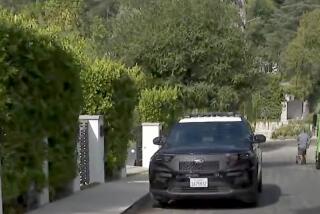Valley Leading City in Domestic Violence : Crime: Police say the Van Nuys Division recorded the most arrests during the first three months of the year.
- Share via
For reasons that police, prosecutors and social workers are hard-pressed to explain, the San Fernando Valley is leading the rest of the city in domestic violence cases.
And the Los Angeles Police Department’s Van Nuys Division--where the tragic Pantoja case unfolded Thursday--reported more domestic violence cases during the first part of this year than any of the city’s 17 other police patrol areas, continuing a three-year trend.
“I don’t know whether this is good news or bad news--whether it means more domestic violence or more consistent following of police procedures,” said Carol Arnett, coordinator of the Los Angeles County Domestic Violence Council.
Police Department statistics show that the Valley’s five patrol areas reported 579 domestic violence arrests during January, February and March. The highest number of arrests--211--was made in the Van Nuys Division.
Of the department’s three other geographic bureaus, the Central Bureau came closest with 436 arrests, followed by the South Bureau with 407 and West Bureau with 326. Among the city’s 18 patrol areas, the Central Bureau’s Rampart Division, just north of downtown Los Angeles, came closest to Van Nuys’ record with 162 domestic violence arrests.
The Valley also led the city in domestic violence cases during the first quarters of 1991 and 1992, department records show, with 543 and 592 arrests, respectively.
But as Arnett and several other experts in the field suggested, the numbers might simply mean that police in the Valley are doing a better job of responding to domestic violence calls.
“I don’t think the Valley has a significantly worse problem than other places,” said Betty Fisher, director of the Haven Hills Family Violence Center, the Valley’s only shelter for battered women and their children.
“I would think that . . . somebody’s paying attention in the (police) divisions in the Valley,” Fisher said.
Arnett suggested that police in the Valley might have more time to respond to domestic violence calls than officers elsewhere in the city. “Maybe when you’re dealing with rampant gang violence and other problems you don’t prioritize domestic violence,” she said.
More arrests could also reflect greater awareness of domestic violence as a crime, and a willingness on the part of relatives and neighbors to get involved, said both Fisher and Gail Pincus, director of the Domestic Abuse Center in Northridge.
“The more connected a victim is, the more likely she is to seek help and to get it,” Pincus said.
Documented domestic violence incidents have been steadily increasing in Los Angeles--from 19,418 in 1986 to 43,691 in 1992. Van Nuys Detective Mitch Robins, who oversees the Crimes Against Persons unit there, attributed much of the rise to a 7-year-old state law requiring police to keep written records of domestic violence calls even when the victim is unwilling to pursue criminal charges.
But Robins was at a loss to explain why his patrol area has been generating the most domestic violence cases in the city. “All I know is our workload here is tremendous and a lot of it has to do with domestic violence,” Robins said.
Several experts dismissed the notion offered by many police that the Valley’s growing immigrant population is responsible for a rise in domestic violence, and that spousal abuse is particularly prevalent among Latinos. In fact, those experts said, domestic violence knows no ethnic, racial or economic bounds. Affluence just makes it easier to hide.
“The richer you are, the more isolated you are, and therefore more can go on behind closed doors,” Pincus said. “Rich people are going to call their lawyer first, or their psychiatrist. . . . They’re just more prone to keep things quiet.”
Deputy City Atty. Alana Bowman, who supervises domestic violence prosecutions, agreed.
“When I worked in West L.A., we saw many white, upper middle-class people,” Bowman said. “In Bel-Air, once we literally had a guy who was arraigned and came to court in a chauffeur-driven car.”
Bowman said the most important thing about the Valley’s domestic-violence lead is the fact that it is surprising and dispels stereotypes.
“It goes against our expectations and that is exactly the fact about domestic violence,” she said. “That who we expect to be the victim is not as we expect. . . . That the victims really do look like ourselves.”
More to Read
Sign up for Essential California
The most important California stories and recommendations in your inbox every morning.
You may occasionally receive promotional content from the Los Angeles Times.










